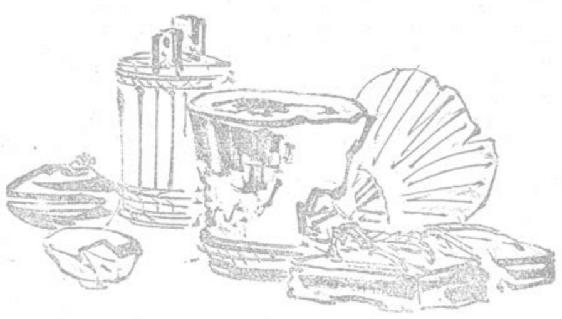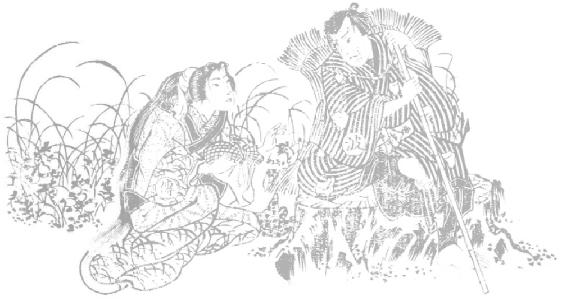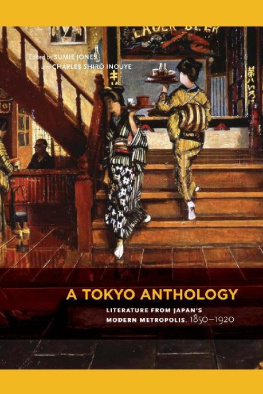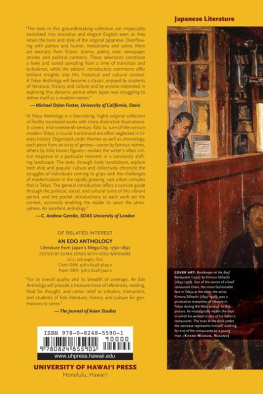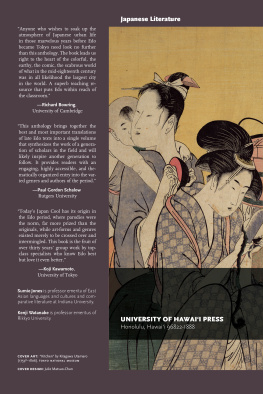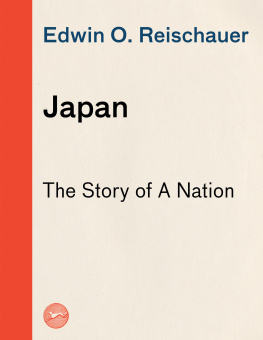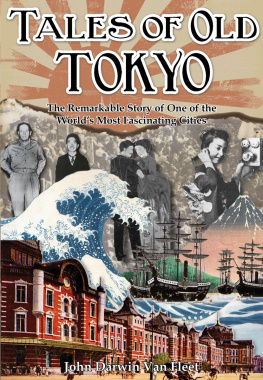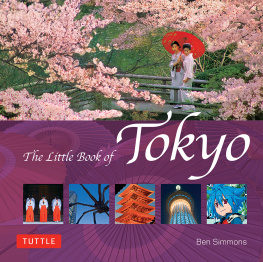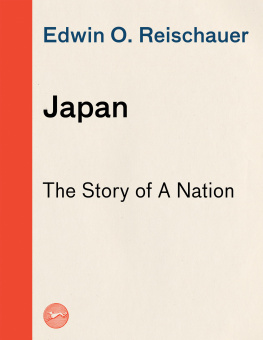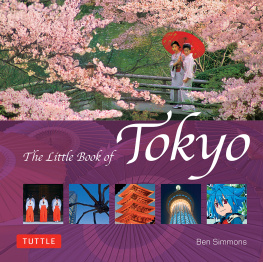A Tokyo Anthology
Edited by Sumie Jones
and Charles Shir Inouye
advisory board
H oward H ibbett
S hinji N obuhiro
A Tokyo Anthology
LITERATURE FROM JAPANS
MODERN METROPOLIS, 18501920
Copyright
2017 university of hawaii press
All rights reserved
Printed in the United States of America
22 21 20 19 18 17 6 5 4 3 2 1
Library of Congress Cataloging-in-Publication Data
Names: Jones, Sumie, editor. | Inouye, Charles Shir, editor.
Title: A Tokyo anthology: literature from Japans modern metropolis, 18501920 / edited by Sumie Jones and Charles Shir Inouye.
Description: Honolulu: University of Hawaii Press, [2017] | Includes bibliographical references and index.
Identifiers: LCCN 2016039442| ISBN 9780824855895 (cloth; alk. paper) | ISBN 9780824855901 (pbk.; alk. paper)
Subjects: LCSH: Japanese literatureMeiji period, 18681912Translations into English. | Japanese literatureTaish period, 1912-1926Translations into English.
Classification: LCC PL726.6.T63 2017 | DDC 895.6/080042dc23
LC record available at https://lccn.loc.gov/2016039442
Publication of this book has been assisted by grants from the following organizations:
T he S untory F oundation
University of Hawaii Press books are printed on acid-free paper and meet the guidelines for permanence and durability of the Council on Library Resources.
Text design and composition by Julie Matsuo-Chun, with display type in Gabriola Regular and Akzidenz Grotesk and text type in Arno Pro.
Preface
While Edo, the seat of the Tokugawa shogunate, had been designed and built largely from scratch, Tokyo was an invention superimposed on the already developed metropolis. This fact is emblematic of the nature of the city. The merging of and conflicts between two different stages of modernization not only characterized the citys life and culture but also stimulated the growth of a unique literary milieu.
This volume follows An Edo Anthology: Literature from Japans Mega-City, 17501850 (University of Hawaii Press, 2013), which introduced the popular urban literature of Edo before it became Tokyo, and another volume is currently under preparation, tentatively entitled A Kamigata Anthology: Literature from Japans Metropolitan Centers, 16001750. All three anthologies aim at providing an experience akin to that of the original reader by re-creating the tone and style of the original texts in these English versions, as well as maintaining their formats, particularly when the narratives are embedded in pictures. We provide a detailed introduction to each volume, describing the social and political context that impacted the creators and readers of the time. An introduction to each text places works in the context of real life and literary history, while the Notes for the Reader and the Source Texts sections provide information for the further appreciation of the works, enabling us to do without footnotes, which could interfere with the flow of the translations. Instead of chronological or genre organization, the arrangement of the contents reflects larger topics and themes found in the literature as well as in the lives of people of the time. This arrangement allows readers to focus less on literary historical development and more on issues that concerned Meiji writers as they merged old traditions and new trends.
A Tokyo Anthology tells the story of a modern urban literature, which, like the physical structure of Tokyo itself, was influenced by Western Enlightenment but also rose out of the innovations of earlier popular culture. This literature also reveals the economic, political, and military turmoil of the time as well as Meiji writers responses to the reality of their day. Beginning with oral and dramatic performances, this volume follows traditional forms as they transform into prose fiction and then mature into the modern novel, thanks to the trends of realism and the colloquial writing movement. The native Japanese tradition was inclined toward lyricism, but new trends and forms arose in response to the introduction of Western Romantic poetry. The contents of this volume also reflect the Meiji periods dynamic shift from the oral and pictocentric to the written and logocentric, although essential elements of spoken-ness, lyricism, and pictocentrism were carried over to these new forms of prose writing.
Although this volume highlights the novel as the epitome of modernity, it can only represent the genre in short selections. Similarly, drama here takes the form of selections from plays. In addition, since the aspects of performance and production cannot be represented on paper, we have chosen to select only one scene from a single kabuki play, which most conspicuously dramatizes the conflicts between Edo and Meiji, and Japan and the West. In presenting poetry, this volume does not attempt at being comprehensive in terms of the many forms that survived from earlier periods and those that emerged anew, but it illustrates the variety of imagination and expression according to the topical interests of the period. At the same time, the volume emphasizes new forms of orality by including works of staged storytelling and protest songs. It also testifies to the lingering force of ocularity in Meiji culture in spite of the modern spread of logocentrism. Woodblock-printed graphic novels coexisted alongside movable-type books; and journals were often adorned by innovative modernist designs.
A Tokyo Anthology features the use of original first-edition materials. Many works of Meiji-period literature were first serialized in newspapers or journals, of which legible copies are not always extant, making our search for the best versions of these first editions complex. Unlike their Edo counterparts, which consisted of handwritten woodblock-printed pages, Meiji books largely used letterpress printing, which affected the relationship between the picture and the written text. Because of the stylistic, orthographic, and other complexities of Meiji literature, our translators had to be equipped not only with a broad knowledge of the period but also with the literary talent required to accommodate the wide variety of Meiji writing. The planning committee and advisers emphasized these requirements, making sure to mix distinguished scholar-translators with up-and-coming ones. The Source Texts section lists the original publications as well as their modern editions. For rare books, we list at least one owner of a copy (with the date of publication).
All of the translations are original and have not been previously published as they appear here. Most are the first translations of these works into English, with a few exceptions. For works that were previously partially translated into English, we chose different episodes or chapters to represent here.
This is the case for works such as Kanagaki Robuns Things Heard around a Pot of Beef, of which a different episode has been published in Donald Keenes Modern Japanese Literature (1956), and Shunkintei Rys The Bad Girl Prefers Black and Yellow Plaid , of which Jones has previously translated different episodes from the same work in her The Shirokoya Scandal (2010). An earlier translation, although partial, of Kawakami Otojirs Oppekepe Rap is included in Joseph L. Andersons Enter a Samurai: Kawakami Otojir and Japanese Theatre in the West, Vol. 1 (2011). Earlier versions of Laurel R. Rodds translations of Yosano Akiko poems have been published, but the translations in this volume have been further refined for their inclusion. The collection is so popular that many selections have been put into English, most conspicuously in Sanford Goldstein and Seishi Shinodas Tangled Hair: Selected Tanka from Midaregami (1971).



